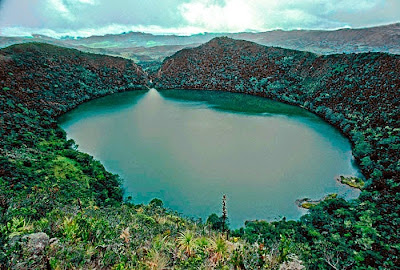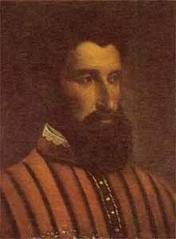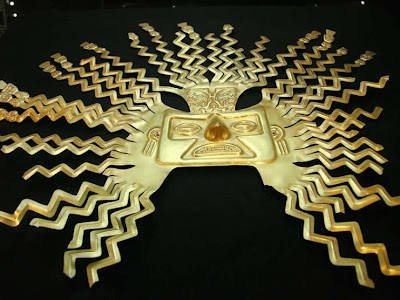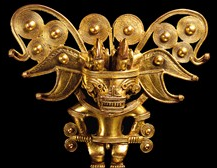 The Muisca practiced a ritual for every new king. | For hundreds of years, treasure hunters searched for El Dorado, the lost city of gold. In spite of countless expeditions all over Latin America, the city of gold remains legend, with no evidence of its existence. The origins of El Dorado come from the Muisca tribe. Following two migrations – one in 1270 BC and one between 800 and 500 BC, the Muisca occupied the Cundinamarca and Boyacá areas of Colombia.  |  Bird-man adornment from the Cauca tribe (AD 900-1600), believed to give the wearer the skill of the creature |
 Muisca raft. It was found in a cave in Pasca, Colombia in 1856. Circa 1200 to 1500 BC. | During one of these rituals, the new king would be brought to Lake Guatavita, where he would be stripped and covered in gold dust. He was placed on a decorated raft, along with attendants and piles of gold. The raft went to the center of the lake, where the king would dive in, washing the gold dust from his body, as attendants threw gold into the lake. This ritual was a sacrifice to the Muisca Gods. To the Muisca, 'El Dorado' wasn't a city, but the king at the center of the ritual, also called “the Gilded One.” |  |
 | Laguna de Guatavita is located 50 km north-east of Bogotá. Conquistadores Lázaro Fonte and Hernán Perez de Quesada attempted to drain the lake in 1545 using a bucket chain of labourers. |  |
 | After 3 months, the water level had been reduced by 3 metres, and only a small amount of gold was recovered. In 1580 Antonio de Sepúlveda had a notch cut deep into the rim of the lake, which managed to reduce the water level by 20 metres, before collapsing and killing many of the labourers. Various golden ornaments, jewellery and armour were found. Sepúlveda died a poor man, and is buried at the church in the small town of Guatavita. |  |
 | In 1898 the lake was drained by means of a tunnel that emerged in the centre. The water was eventually drained to a depth of about 4 feet of mud and slime. When the mud dried in the sun, it set like concrete. A haul of only £500 was found, and subsequently auctioned at Sothebys of London. The Colombian government declared the lake a protected area in 1965. |  |
 | Bogota’s Museum of Gold looks at the reality behind the stories that excited the European imagination from the 16th century onwards. As the legends shifted, so has the location of El Dorado. Searches span all areas of Latin America. Expeditions to find El Dorado have been conducted far and wide and continue to this day. |  |
 |  |   |

No comments:
Post a Comment